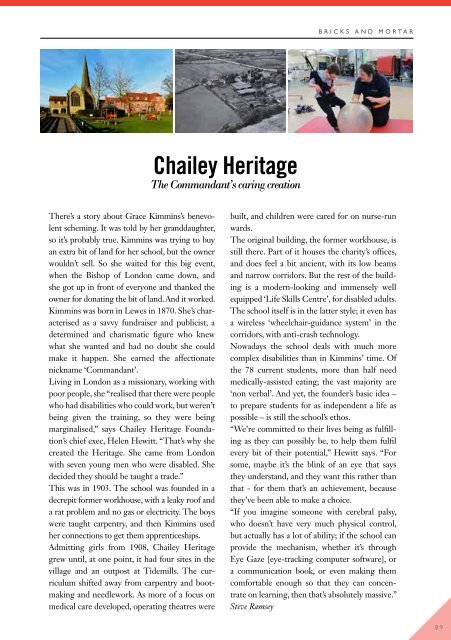Create successful ePaper yourself
Turn your PDF publications into a flip-book with our unique Google optimized e-Paper software.
icks and mortar<br />
Chailey Heritage<br />
The Commandant’s caring creation<br />
There’s a story about Grace Kimmins’s benevolent<br />
scheming. It was told by her granddaughter,<br />
so it’s probably true. Kimmins was trying to buy<br />
an extra bit of land for her school, but the owner<br />
wouldn’t sell. So she waited for this big event,<br />
when the Bishop of London came down, and<br />
she got up in front of everyone and thanked the<br />
owner for donating the bit of land. And it worked.<br />
Kimmins was born in <strong>Lewes</strong> in 1870. She’s characterised<br />
as a savvy fundraiser and publicist, a<br />
determined and charismatic figure who knew<br />
what she wanted and had no doubt she could<br />
make it happen. She earned the affectionate<br />
nickname ‘Commandant’.<br />
Living in London as a missionary, working with<br />
poor people, she “realised that there were people<br />
who had disabilities who could work, but weren’t<br />
being given the training, so they were being<br />
marginalised,” says Chailey Heritage Foundation’s<br />
chief exec, Helen Hewitt. “That’s why she<br />
created the Heritage. She came from London<br />
with seven young men who were disabled. She<br />
decided they should be taught a trade.”<br />
This was in 1903. The school was founded in a<br />
decrepit former workhouse, with a leaky roof and<br />
a rat problem and no gas or electricity. The boys<br />
were taught carpentry, and then Kimmins used<br />
her connections to get them apprenticeships.<br />
Admitting girls from 1908, Chailey Heritage<br />
grew until, at one point, it had four sites in the<br />
village and an outpost at Tidemills. The curriculum<br />
shifted away from carpentry and bootmaking<br />
and needlework. As more of a focus on<br />
medical care developed, operating theatres were<br />
built, and children were cared for on nurse-run<br />
wards.<br />
The original building, the former workhouse, is<br />
still there. Part of it houses the charity’s offices,<br />
and does feel a bit ancient, with its low beams<br />
and narrow corridors. But the rest of the building<br />
is a modern-looking and immensely well<br />
equipped ‘Life Skills Centre’, for disabled adults.<br />
The school itself is in the latter style; it even has<br />
a wireless ‘wheelchair-guidance system’ in the<br />
corridors, with anti-crash technology.<br />
Nowadays the school deals with much more<br />
complex disabilities than in Kimmins’ time. Of<br />
the 78 current students, more than half need<br />
medically-assisted eating; the vast majority are<br />
‘non verbal’. And yet, the founder’s basic idea –<br />
to prepare students for as independent a life as<br />
possible – is still the school’s ethos.<br />
“We’re committed to their lives being as fulfilling<br />
as they can possibly be, to help them fulfil<br />
every bit of their potential,” Hewitt says. “For<br />
some, maybe it’s the blink of an eye that says<br />
they understand, and they want this rather than<br />
that - for them that’s an achievement, because<br />
they’ve been able to make a choice.<br />
“If you imagine someone with cerebral palsy,<br />
who doesn’t have very much physical control,<br />
but actually has a lot of ability; if the school can<br />
provide the mechanism, whether it’s through<br />
Eye Gaze [eye-tracking computer software], or<br />
a communication book, or even making them<br />
comfortable enough so that they can concentrate<br />
on learning, then that’s absolutely massive.”<br />
Steve Ramsey<br />
89


















